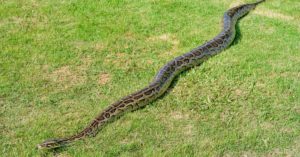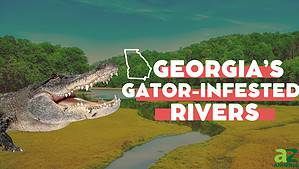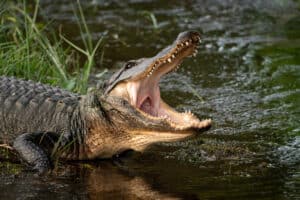Alligators are naturally afraid of humans, which explains why cases of them attacking humans are rare. As a result, the chances of losing life to alligator attacks are even slimmer.
But frequent run-ins with these creatures have resulted in several unprovoked attacks in Florida.
Florida is the unofficial home of alligators, and residents encounter these reptiles in golf courses, homes, and roads.
Given that alligators’ natural habitat is near water bodies, it is hardly surprising that most Florida lakes are alligator-infested.
Several alligator attacks were recorded in Florida in 2022, but only three happened in lakes.
Let us examine three of the lakes where these attacks occurred.
1. Taylor Lake, Florida
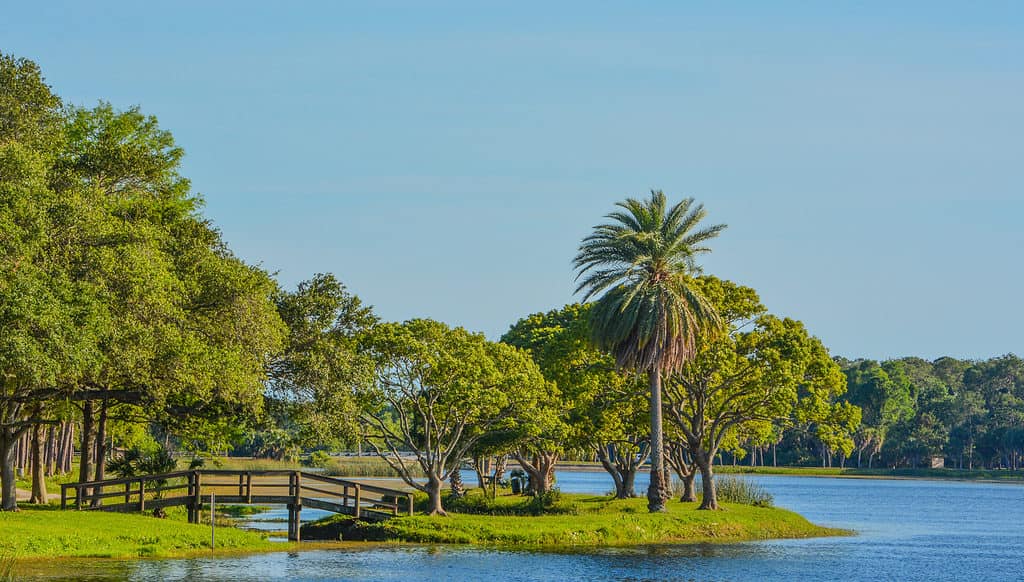
Taylor Lake is a five-acre freshwater lake connected to the 156-acre John S. Taylor Park via the Pinellas Trail.
©Norm Lane/Shutterstock.com
Taylor Lake is not the most crocodile-infested water body in Florida, but it is the location of the first incident involving an alligator attack in 2022.
Taylor Lake is a five-acre freshwater lake connected to the 156-acre John S. Taylor Park via the Pinellas Trail. The park offers several amenities, including a disc golf course, a walking trail, and fishing activities on the lake.
The trail to Taylor Lake starts with a flat area followed by a steady climb towards the lake. The climbing section of the course has a constant elevation with few viewpoints where one can stop to rest. It is a challenging but manageable trail.
The trail begins at the park’s parking lot, which is separated from the park by a wildlife gate. Once you walk past the gate, you will see the marked trail to the lake on the right-hand side. You will cover the flat section in a few minutes before embarking on the continuously climbing section that covers 3.7 miles to the lake.
The climb will take you across several scenic footbridges, including the one that lies over Taylor Creek. Once you cross the second bridge, you can either continue on the path toward Taylor Lake or take the diversion towards O’Brien Lake, some 1.3 miles away.
Once you get to Taylor Lake’s shores, you can spot Munt Bell, which rises 2,379 feet above the lake level. A waterfall also magnetically descends a 164-foot high cliff on the lake’s western side. There is also a camping site along the shores of the lake where you can relax after the unforgiving climb to the lake.
Taylor Lake is popular among hikers between Lake Louse and Banff because it does not have much traffic compared to the other parks near these towns.
Many of those who visit the lake fish for cutthroat trout. Ensure you have your fishing license if you plan to engage in the activity on the lake.
The lake area is also popular among golfers, given the beautiful course on the shores.
Despite the scenic environment and inviting waters, swimming is discouraged in the lake. The park’s management has installed several signs warning visitors to avoid feeding the alligators or swimming in the lake.
The only fatality involving a water body occurred when an individual got into the lake searching for discs that were lost by players on the park’s disc golf course. News outlets reported the case of 47-year-old Sean McGuiness, who earned a living by retrieving disc golf discs and selling each for $5. He would make up to $150 daily from this job. Unfortunately, as fate would have it, McGuiness’s risky job eventually cost him his life after an alligator attack.
Largo Police retrieved Sean McGuiness’s body from the alligator-infested Taylor Lake on May 31, 2022. McGuiness’s body had three missing limbs, and he is suspected of drowning after getting attacked by the gators.
Despite knowing about the danger of working in the alligator-infested lake, he never seemed bothered by the threat, despite not having health insurance.
McGuiness had epilepsy and was diagnosed with a pituitary gland tumor. His struggles with his health complications and his determination to work instead of begging for food could have led him to take the risky job.
To make things worse, McGuiness was retrieving the discs during the early morning hours, alone, before people arrived at the disc golf course. Police suspect that the alligators were in their mating or nesting season when they became most irritable, which explains why they viciously attacked McGuiness.
2. Lake Manatee, Florida

Lake Manatee is an artificial water body resulting from a dam constructed along the Manatee River.
©Ebyabe / CC BY-SA 3.0 – License
Lake Manatee is part of the expansive 556-acre Lake Manatee State Park. It covers 2,400 acres and extends three miles from the southern section of the beautiful lake.
Lake Manatee is an artificial water body resulting from a dam constructed along the Manatee River. The dam was constructed sometime in the 1960s.
The freshwater lake is excellent for fishing, boating, kayaking, and canoeing. However, the park management limits the maximum boat motor to 20 horsepower.
You can capture various fish species, including speckled perch, sunshine bass, catfish, shell cracker, and bluegill. However, only those with freshwater fishing licenses can engage in these activities.
There is a small swimming beach along the lake’s shores where you could cool off during the summer. Unfortunately, the park does not have lifeguards; swimming is at one’s own risk.
Lake Manatee also serves as a freshwater reservoir for Sarasota and Manatee counties. Pine flatwoods cover a significant proportion of the park, although hardwood and sand pine forests are also found within the park.
Lake Manatee park offers visitors several activities, including spotting several species of wildlife, including bobcats, quail, deer, and gopher tortoises. Although the lake’s name suggests that one will see a lot of manatees, visitors will not see any at the park because the dam prevents them from reaching the lake.
The park has a camping site located near the lake. It also has several trails, the top of which are the Gopher Trail Loop, Lake Manatee East Loop, and the Lake Manatee Loop. You can access these trails from the campground.
The second alligator attack on a lake happened to Eric Merda while swimming across the lake. An alligator attacked Merda as he swam in Lake Manatee Fish Camp on July 17, 2022, leaving him without an arm. Merda was visiting the fish camp when he lost his way while strolling in the woods.
Merda was walking solo along one of the trails, took some diversions, and found himself at the shores of Lake Manatee. He figured out that his camp was on the opposite side of the lake and decided to swim across rather than walk around it.
Not long after he began swimming, Merda spotted an alligator approaching his right side. The gator grabbed his right arm and began dragging him underwater while performing death rolls. Merda managed to come up three times during the struggle before the alligator took off with significant parts of his arm.
Merda swam to the shore, began screaming for help, and eventually got assistance three days later. The alligator did not bite off his entire arm, and the doctors at Sarasota Memorial Hospital performed a surgery involving amputating the remaining parts of his right arm.
Luckily, Merda lived but lost one arm.
3. Lake Thonotosassa, Florida
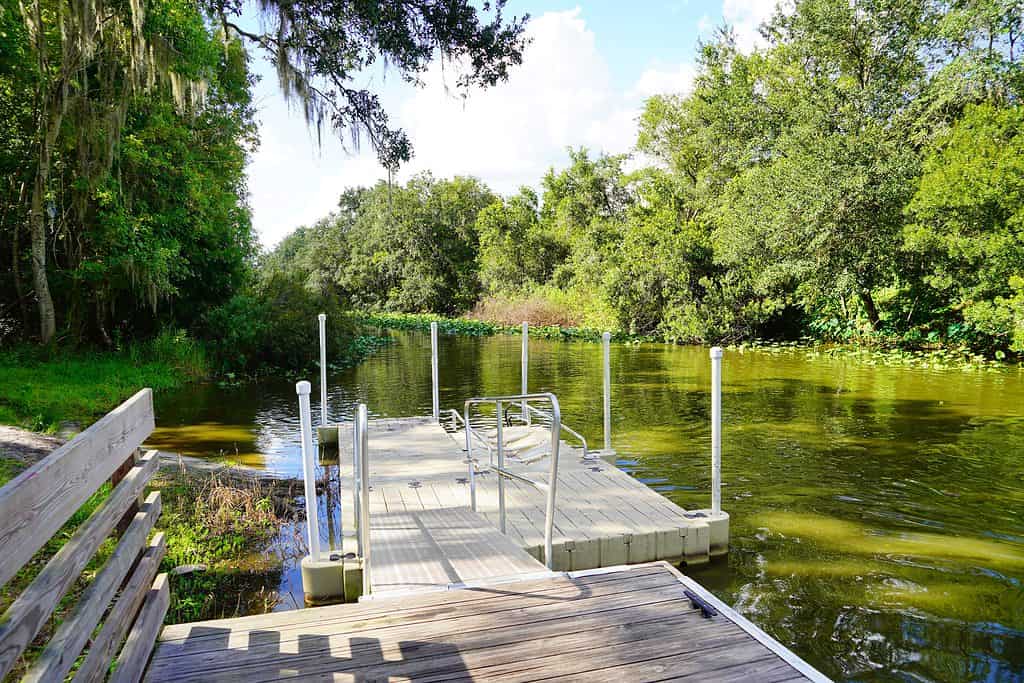
Lake Thonotosassa presents many recreational activities for residents and visitors.
©Feng Cheng/Shutterstock.com
Lake Thonotosassa covers more than 800 acres and is the largest in Hillsborough County. It is also a private lake located 33 feet above sea level.
The lake’s average depth is six feet, and the deepest part is 13 feet.
Residential homes surround the lake, but you can access it using any of the four roads that go around the water body.
Thonotosassa Road lies on the southern part of the lake, while the Taylor Highway is on its western side. The Knights-Griffin Road is at the northern part of the lake, while the McIntosh Road allows you to access the eastern part of the lake.
The lake gets its name from the Thonotosassa area, a critical quarry for Seminole Indians. The natives sourced spearheads, arrowheads, and other tools from lake mines.
The lake was also a religious site. American Indians performed feasts, ceremonies, and marriages in the area. The U.S. government relocated many Seminole Indians to the area around the lake during the 19th-century Seminole Wars. European immigrants later settled in the place.
Lake Thonotosassa presents many recreational activities for residents and visitors. The Hillsborough River State Park, one of the state’s parks, is a popular zone near the lake. Visitors can canoe, kayak, and ride bikes and golf cart rentals in the park.
The lake is popular among those who love to fish for bluegills, black crappies, and largemouth bass.
The third attack incident involving alligators occurred in this lake.
News outlets in early August shared the story of a 12-foot alligator attacking Juan Carlos La Verde. La Verde was recording an instructional film for his organization on August 3 when the alligator attacked and engulfed his upper body up to his torso area.
La Verde did not have any safety goggles, and the low visibility made it difficult for him to see the approaching alligator. By the time he noticed that he was under attack, almost half of his body was in the alligator.
His assistant, who was filming the instructional video, captured the horrific attack using a drone that he was flying overhead.
La Verde later described the horror of realizing that the beast was swallowing him alive. He recalls feeling the reptile’s teeth and tongue piercing his face, upper body, and skull. He even heard a popping sound when the animal’s jaw snapped.
Luckily, the scary incident only lasted a few seconds, and La Verde managed to wrestle his way out of the jaws of death.
La Verde attributed his survival to his instincts, luck, and divine intervention. He somehow managed to place his hands inside the gator’s mouth, felt its teeth as it struggled, and rolled with him in water. He also does not know why the alligator suddenly decided to let go, allowing him to safety.
He swam until he got to a home across the attack area. Despite his injuries, La Verde managed to get out of the lake and asked for assistance for two kids he found at home. The children contacted their mother, who quickly called the emergency response team.
Later in the emergency room, La Verde underwent a six-hour craniotomy and jaw surgery that saw surgeons remove a section of his temporal lobe. Apart from the bite marks and losing blood, La Verde had experienced multiple injuries on his shoulders and back and severe nerve damage on the right side of his face.
Summary of 3 Florida Lakes with Alligator Attacks in 2022
Here’s a recap of three lakes in Florida where alligator attacks occurred in 2022.
| Number | Lake | Size | Attack |
|---|---|---|---|
| 1 | Taylor Lake | Five-acre freshwater lake connected to the 156-acre John S. Taylor Park | Sean McGuiness fatally attacked on May 31, 2022 |
| 2 | Lake Manatee | Part of the expansive 556-acre Lake Manatee State Park | Eric Merda attacked on July 17, 2022 and lost an arm |
| 3 | Lake Thonotosassa | Covers more than 800 acres and is the largest in Hillsborough County | Juan Carlos La Verde attacked on August 3, 2022 and experienced multiple injuries |
Conclusion
Florida is the unofficial home for alligators, given the high number of these reptiles in the state. Alligators naturally live near water bodies, and a large population of alligators lives in Florida’s lakes. Although alligators are naturally afraid of humans, frequent encounters with people sometimes result in injuries and fatalities. In 2022, one fatality was recorded in Taylor Lake while two people lost their limbs to these reptiles in Lake Manatee and Lake Thonotosassa.
The photo featured at the top of this post is © Jillian Cain Photography/Shutterstock.com
Sources
- Bay News, Available here: https://www.baynews9.com/fl/tampa/news/2022/06/08/gator-taylor-lake-mcguinness
- Fox 13 News, Available here: https://www.fox13news.com/news/its-do-or-die-man-loses-arm-after-surviving-alligator-attack-at-lake-manatee
- Tampa Bay, Available here: https://www.tampabay.com/news/2022/08/26/never-saw-the-alligator-how-a-tampa-bay-man-survived-vicious-attack/
Thank you for reading! Have some feedback for us? Contact the AZ Animals editorial team.



